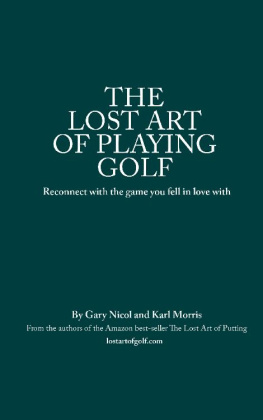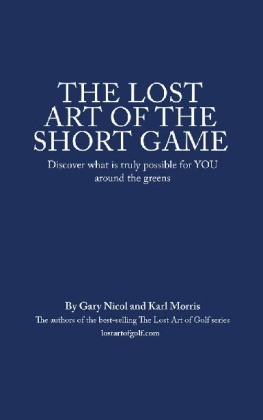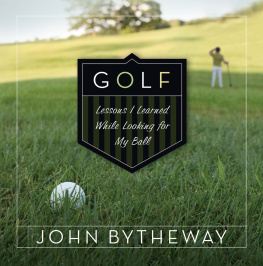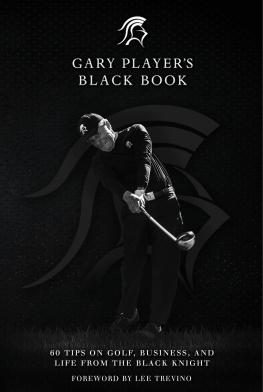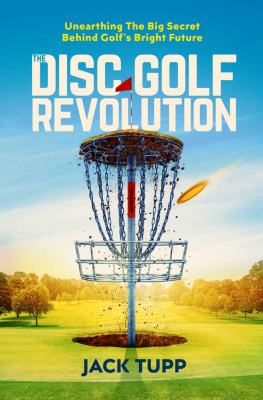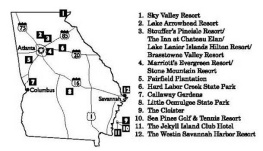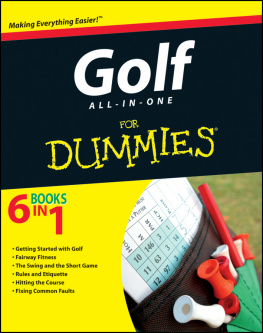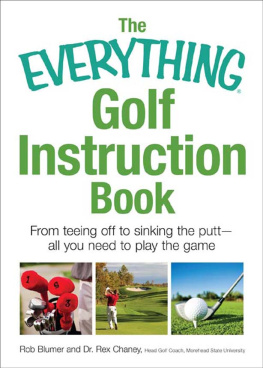About Sports Publications
Sports Publications are specialist golf publishers across magazines, books and digital formats.
They publish: National Club Golfer, Lady Golfer, NCG Top 100s, Society Golf Guide, The Golf Club Manager, Great Golf in England and BIGGAs Your Course as well as nationalclubgolfer.com, lady-golfer.com and several external titles.
The Lost Art of Playing Golf was edited by Dan Murphy, content director at Sports Publications.
Foreword
By Rudy Duran, Tiger Woods first coach
The first I saw of Tiger Woods was when his mother, Tida, brought him to me at Heartwell Golf Park in Long Beach, California.
Heartwell is an 18-hole, par-3 course where I worked as one of the golf professionals.
Tida wanted to know if Tiger could be part of my junior programme and would I coach him. Tiger was four years old at the time and could barely see over the pro shop counter. I said wed go to the driving range where I could see Tiger hit some balls.
I teed up four balls for him. He took out his cut-down 2 1/2 wood and proceeded to hit four perfect drives about 60 yards with a little bit of draw.
I said: Wow he can play here anytime and I would love to help with his game.
I knew at that moment that Tiger was special.
What I didnt know was how much I would learn from Tiger and that I was actually signing up to be the student.
I became a golf professional in 1971. I tried my hand at tournament golf from 1976 to 1978 with little success. I could hit the ball great in all areas but my scoring was always weak.
During those years of full-time golf I thought that if I just had the correct formula of positions I would always shoot low scores.
Well, that never happened. Hitting the ball well on the driving range and shooting low scores on the golf course are not the same thing.
I actually became the expert on what I was doing wrong when I needed to be the expert on my good shots and what I did well.
When Tiger and I would get together he would practise with me on the practice area and on the golf course.
We never spent much time talking about what was wrong.
Its more fun to celebrate our success. We would hit chip and pitch shots with different trajectories. High ones, low ones, shots that stopped, shots that ran out.
He just loved to create different golf shots. He wanted to know how to make the ball fly in different ways so he could score lower. He wouldnt have known about the position at the top of the swing or when he set his wrists.
If he wanted to learn a certain shape of shot I offered some suggestions as to how the club might feel through the ball to affect the flight of the shot.
Our sessions were all about creating an environment of fun, learning and remembering what we did well to make the ball fly how we wanted.
Tiger loved to play and compete in my weekly junior golf tournaments. When Tiger played with Earl and me, he played from the same tees as we did.
Because Tiger was much smaller in size we were getting a huge distance advantage. To balance this out I created Tiger Par so the par of the hole was adjusted relative to how far he hit the ball at that point in time. This way he would know how he was playing relative to his personal par. He might get a six on what was a par-4 hole, but that was a Tiger Par because it took him four good shots to get on the green plus two putts.
As he began to hit the ball further the Tiger par was adjusted accordingly. I remember one day we played together and he went out and shot eight under his personal par. He chose all his own shots, picked all of his own clubs and holed every putt.
He didnt hit the ball much further than 100 yards. He was just five years old and not a big five-year-old at that.
But where you could really see his skill was around the green.
He could pitch, chip and putt like a tour pro.
I believe his short game was great because he had a natural ability to see the ball flight in advance and feel the club to make the ball fly the way he saw it.
Its much like driving a race car. Yes, to win a professional car race like the Indy 500 you need a fast car. But you also need to know how to drive a fast race car.
Even if I had an Indy 500 race car I would still never win the race because I dont know how to drive a race car.
The same is true in golf. You can have a great golf swing but if you dont know how to use it you will never win golf tournaments. No matter how great you hit the ball on the driving range. Using your swing to shoot low scores on the golf course is a completely different skill than that of hitting the ball on the driving range.
Since those days in the early 1980s with Tiger and Earl, my coaching has evolved from how I taught in the 1970s.
Now I spend very little time telling my students what to do, I just give them options to explore. Options that allow the player to develop their own game as opposed to trying to fit them into some kind of ideal swing model.
Today I call my coaching Guided Self Discovery.
It is all about the shots we play not the details of how the swing looks. A fade is not a bad shot. It may be inappropriate for this particular moment but if you can remember how it feels to play a fade then you have that shot available when you need it.
Building awareness of your own game is a vital skill to develop because you need to uncover your way to play.
We also need to have the freedom to explore by having a better relationship to poor outcomes. Learn to provide yourself an environment that allows exploration and a willingness to test out what happens with the ball when we apply the club in certain ways.
Learn from the bad and remember the good.
The concepts you are about to read in The Lost Art of Playing Golf resonate with my own philosophy about the art of playing golf. Yes, science can be valuable but when you step out onto the golf course you need to have a game that is adaptable. A game that can produce the shot the golf course requires in each unique moment.
When you embrace the ideas Karl and Gary bring to The Lost Art of Playing Golf you have a chance to connect back to the very source of the game.
Of being like a kid and feeling the joy of creating a golf shot in your mind and then setting your body free to produce that shot.
Thats what kids do in the playground and thats what I saw Tiger do when he was a kid on the golf course.
Gary and Karl bring this style of playing golf to life in this book. You will read, learn and then let your skill free to be as good as you can be. You will be able to use some of the ideas in the book to learn to play golf better and have more fun doing it. By following Gary and Karls advice you will at the very least have a better relationship with the game that will allow you to get much closer to your true potential. Enjoy your journey.
About The Author
Rudy Duran has been a golf professional for over 48 years and is a respected coach and golf course owner/operator. He is best known for being Tiger Woods first golf coach, from the age of four to 10. Currently, Rudy is working on his game, coaching and promoting golf worldwide.
Rudy turned professional in 1971 and has been a member of the PGA of America since 1976. He played on the PGA Tour in 1977 and 1978. He was inducted into the Long Beach California Golf Hall of Fame, received the PGA Tours Card Walker Award for contributions to junior golf and was recognised as the Southern California PGA Northern Chapter Golf Professional of the Year three times.
An Introduction
From the authors

